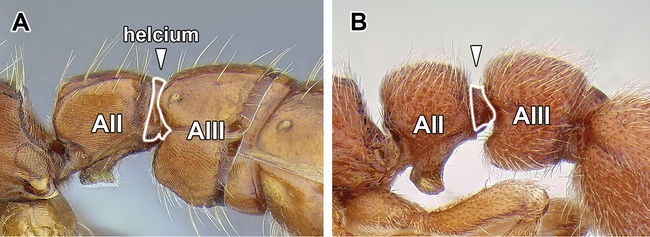Key to North American Genera of Dorylinae
This key to North American genera of the subfamily Dorylinae is based on Borowiec (2016) [1]
1
- Last visible abdominal tergite, the pygidium, not armed with numerous modified setae, at most with only one or two pairs of thick setae or cuticular projections (Figures A, B). Propodeal lobes short or absent .....2
- Pygidium armed with numerous specialized, peg-like or spiniform setae much thicker than surrounding fine hairs (Figure C); setae more than four in number, often more numerous. If pygidium small or with few specialized setae, then propodeal lobes conspicuous .....4
2
return to couplet .....1
- Tarsal claws simple, without teeth (Figure A) (Nearctic, Neotropical, Dominican amber)..... Neivamyrmex (Species key)
- Tarsal claws armed with teeth (Figure B).....3
3
return to couplet .....2
- Inner (flexor) surface of hind tibiae without any sign of differentiated pale cuticle (Figure A) (Nearctic, Neotropical)..... Nomamyrmex (Nomamyrmex esenbeckii)
- Inner surface of hind tibiae with differentiated surface of pale cuticle (metatibial gland), from elongately oval patch near tibial spur to a narrow stripe spanning much of the length of tibia (Figure B)..... Labidus (Labidus coecus)
4
return to couplet .....1
- Helcium circumference large relative to abdominal segment II (petiole) and placed above midheight of the segment, resulting in very low, undifferentiated posterior face of petiole and low anterior face of abdominal segment III (Figure A)..... Acanthostichus (Species key)
- Helcium circumference small relative to abdominal segment II (petiole) placed at about midheight of segment, usually resulting in differentiated posterior face to abdominal segment II and conspicuous anterior face of abdominal segment III (Figure B)..... Syscia (Syscia augustae)



